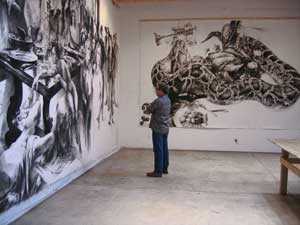James Drake at SITE Santa Fe
BY ARDEN REED

James Drake and his City of Tells Installation
Charcoal is James Drake’s instrument the way the piano was Glenn Gould’s or the clarinet Benny Goodman’s: they’re made for each other. Witness the centerpiece of his SITE Santa Fe exhibition, City of Tells (2002-04), the 12-by-32-foot drawing that gave the show its name. Inspired by Raphael’s School of Athens, Drake’s tableau gathers figures around an elaborately set dining table that recedes diagonally into an arched interior. Additional figures appear before a desert landscape on the left and in the space beyond the arch. The mise-en-scene at once recalls natural-history dioramas and episodes from domestic comedy.
City of Tells was hung like a tapestry–no glass to hamper eyeballing–in a room large enough for viewers to back up and grasp the whole. Walking along the drawing, you encountered Drake’s pantheon, 37 family members and friends interspersed with historical personages and artists who have influenced him. Accompanying his wife, youthful parents and wheelchair-bound aunt are Cormac McCarthy, Diego Rivera, Bruce Nauman, Samuel Coleridge, Terry Allen, Michelangelo, Goya, Gregory Amenoff and Sherrie Levine. Most striking is the sexy pair formed by an expiring figure from Gericault’s Raft of the “Medusa” and Hernan Cortes’s treacherous, androgynous-looking mistress, La Malinche. Even if you don’t recognize them all, their costumes show a range of epochs. The dinner guests feel copresent (Velazquez cheek by jowl with physicist Murray Gell-Mann) like the flowers of different seasons that bloom together in a 17th-century Dutch still life.
City of Tells was preceded in the installation by two 9-by-15-foot drawings placed in a narrow room that forced a close encounter on viewers. One pictured a Burmese python, the other feral hogs, all at the same dining table as in the larger drawing. And in the final room, a three-channel color video was projected on the wall in a 15-minute loop. Each channel showed a banquet table, now furnished with a Thanksgiving feast and with the human eminences replaced by live animals: a python in one instance, pigs in another. In the third portion, a hummingbird alights on the floral centerpiece. It turns out that those apparently fantastic drawings of a snake and hogs at table record actual events–and metaphorically suggest swinish or devious dinner guests.
The color video, however, pales beside the black-and-white artistry of City of Tells. Drake evokes every category of subject matter (history, portraiture, landscape, genre, still life), interweaving private with public, art with science, myth with history. The casual-seeming, easily read composition, which calls no special attention to its own tight organization, offers visual echoes, like repeating hands and feet, and thematic webs, like allusions to Homer, Dante, Gericault and Melville–all four associated with ships. Drake skillfully renders arid plateaus, shiny snakeskin, shadows on gladiolas, cutlery mirrored in polished wood. No less important, he knows when to bear down and when to ease up, alternating precisionist details with abbreviations.
The title comes from the gambling term for a revealing or “telling” gesture or expression, and it’s meant to focus our attention on the figures’ pensive, anxious or wistful airs. Drake’s company feels physically proximate yet emotionally detached, and a melancholy atmosphere presides over the gathering. Not content with graphic bravura alone, Drake has made a deeply felt statement about community and the vibrancy of past cultures, all tempered by a gentle invocation of loss.
